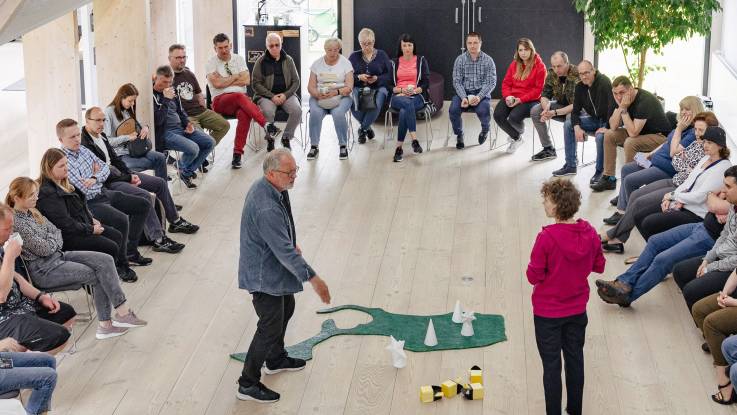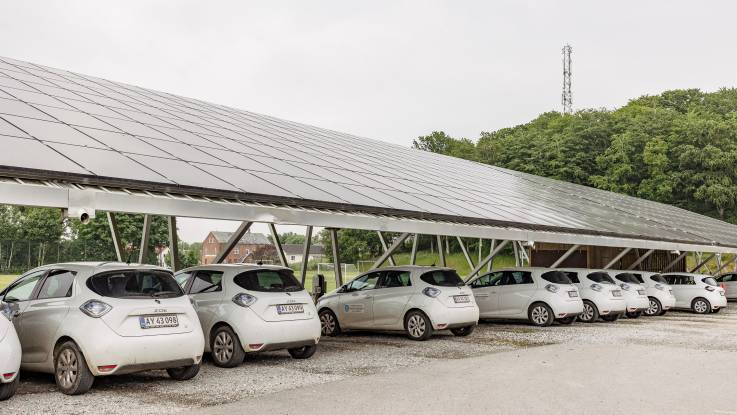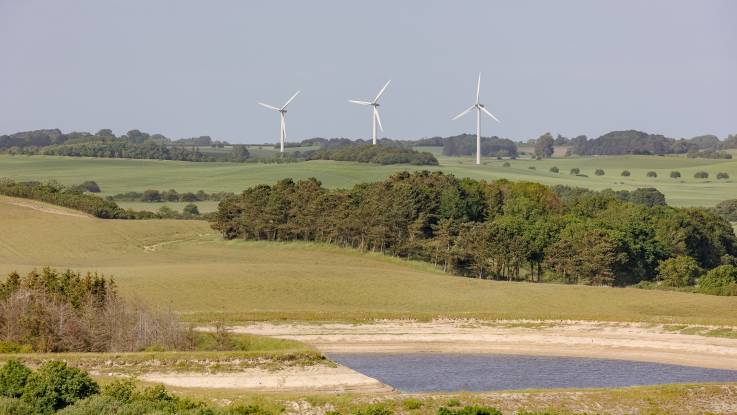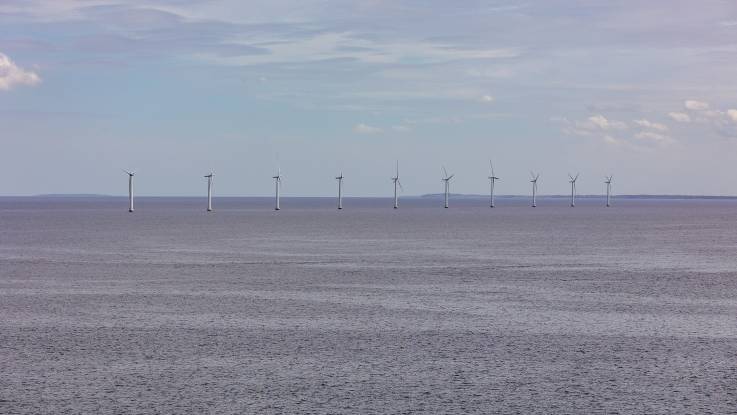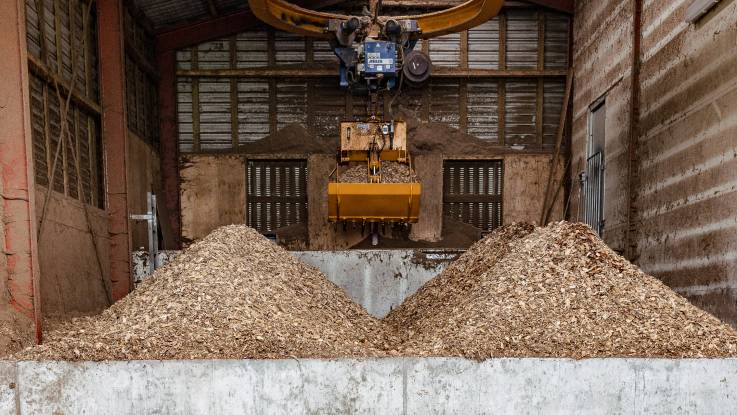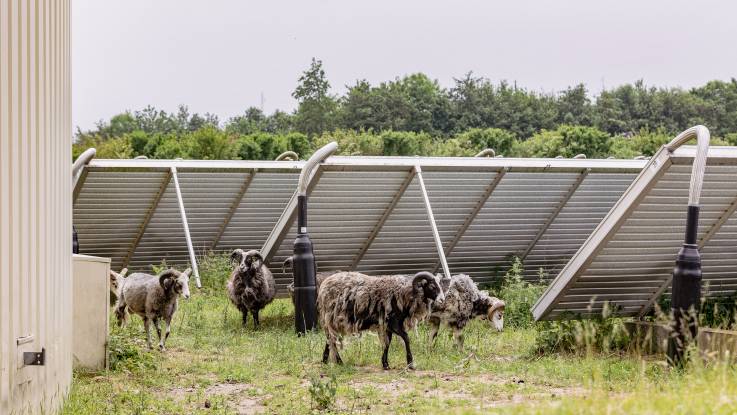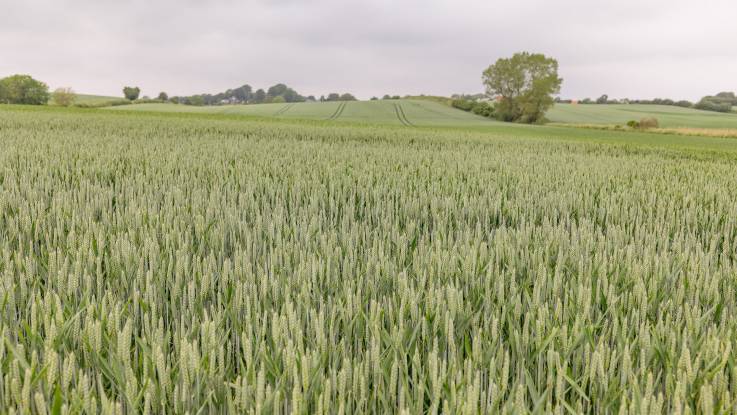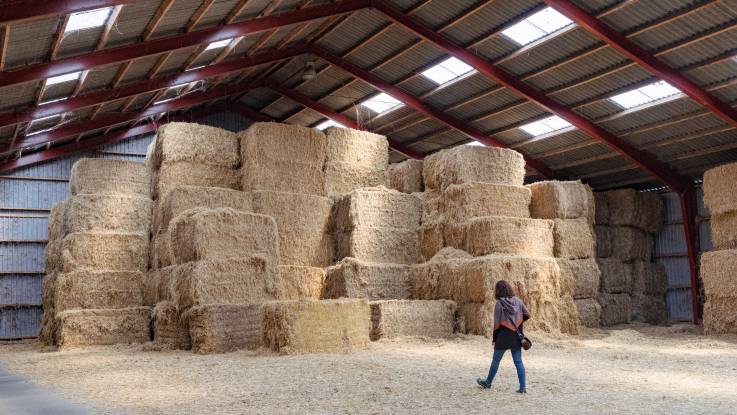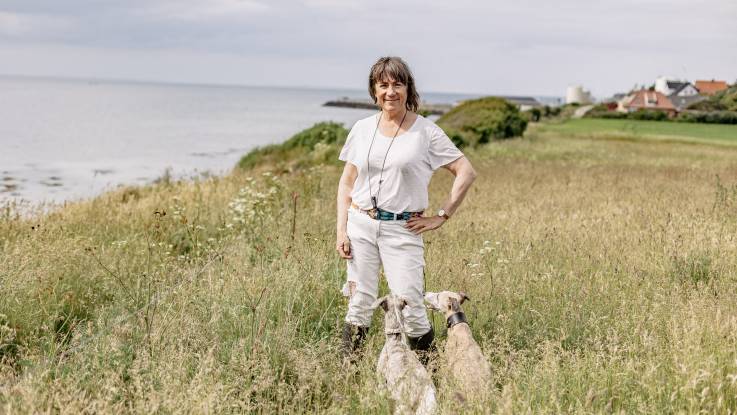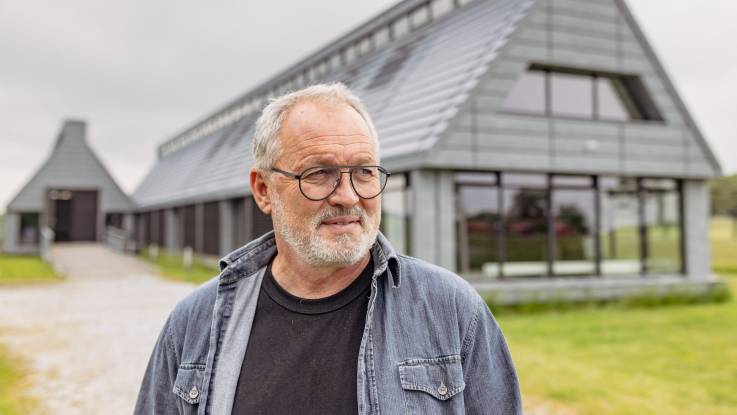Winds of Change on Samsø Island
A report by Anne Backhaus
The Danish island of Samsø produces more energy than it consumes. A dynamic couple and a dedicated community are the secret of its success.
A green-painted chipboard cut-out of Samsø lies on the floor, its outlines roughly sawn. The island has a big round “belly” and a long concave bay on one side that makes it look like a chunk has been bitten out. A nature reserve sticks out at the top of the island like a fin.
“It’s always good to know exactly where you are,” says Søren Hermansen. “And we are right here.” He points to the lower eastern part of the island. “So, where would you put the wind turbines?” Hermansen is the director of Energiakademiet (Energy Academy), an organisation in the small port town of Ballen that carries out a range of work including spreading awareness about renewable energy and how to make the switch. And that is exactly what Hermansen is doing today. The tanned 63-year-old with short grey hair, dressed in black trousers and a denim shirt, is standing next to the chipboard island in the centre of a large circle of chairs. Sitting on the chairs are visitors from Poland. Some eyes are directed at him while others look furtively around the group, uncertain as to whether they are really expected to stand up and place the white cardboard windmills on the wooden island. Hermansen reassures them: “Come on, don’t be shy! This is how we started out back in the day!”
A whole catalogue of ideas
“Back in the day” was 1997, when the Danish energy ministry launched a compelling competition. The challenge was for a manageable, clearly defined region (preferably an island) to become climate-neutral within ten years – without any assistance from the government and using proven technology so that the findings could easily be transferred to other regions. Samsø entered the competition with a whole catalogue of ideas – a now slightly tattered copy of which lies on Hermansen’s desk – and went on to become an official “renewable energy island”. Not all of the ideas in the catalogue were realised, but many were. So successfully, in fact, that the goal of climate neutrality was reached after just eight years. The island, which has since received several awards, is one of the first regions in the world to successfully achieve electricity production 100 percent free of greenhouse gases. By now, the “Samsingers”, as the Baltic Sea islanders call themselves, actually produce more energy than they consume.
One of the ways they achieved this impressive feat was by installing photovoltaic systems on their roofs, eventually becoming the Danish municipality with the most PV modules per inhabitant. Driving through the island’s villages, you will spot these installations on many old farmhouses. There is also a solar thermal power plant in the north with a total collector surface area of 2,500 m². The energy generated there is supplemented by burning wood chips – only ever leftovers from agriculture and forestry. The municipal council, meanwhile, powers its premises and the charging stations for its electric cars with a large PV system installed over the car park.
We rely on various projects to meet our energy requirements.
Many private homes and public buildings are connected to district heating networks set up as part of the energy project. Three straw-burning heating plants provide the local area with heating and hot water. Straw has several advantages: it is cheap, it grows quickly, and it requires little maintenance. Moreover, burning straw releases only as much carbon dioxide as the crops took out of the air while growing. However, the heating stations – large, plain barns densely packed with huge straw bales, with narrow chimneys on the outside – can only supply heat to their immediate surroundings. Residents living further away have therefore installed their own sources of sustainable heat, such as geothermal heat pumps.
And, of course, the Samsingers erected wind turbines – 21 of them, to be precise, and not made of cardboard. Eleven were installed at three locations in the south of the island, while ten more form an offshore wind farm off the south coast. But the cardboard ones have their uses, too: today, Hermansen is using them to explain to a government delegation from 16 districts in Poland how they could accelerate the energy transition in their own country.
A lighthouse project for the energy transition
By now, Samsø has gained worldwide recognition as a shining example of what can be achieved. Every year, around 4,000 interested people from around the world visit the Energy Academy. Here, they receive valuable information, have in-depth discussions, and then travel around the island to visit installations like biomass heating plants. Hermansen – who was named one of TIME magazine’s “Heroes of the Environment” a few years ago – has told the story of his energy island many times. And not only at the Academy: he has appeared before politicians in Copenhagen and Brussels, spoken at conferences, and worked with communities across the globe.
It is immediately obvious that Hermansen is a practised and capable host. His welcome address alone makes the visitors laugh several times. During the introduction round the participants are asked to give their name and – instead of their profession – say which breed of dog they most identify with. The woman with the blond curls feels like a dachshund, her slim neighbour opts for bulldog. Hermansen himself stands there like a border collie, keeping a watchful eye on his “herd”. By the time the cardboard pinwheels are being placed on the model island, everyone is visibly at ease. But no one guesses the correct locations. Hermansen explains in detail why the turbines are, of course, not situated in the nature reserve in the north, nor by the beautiful holiday homes on the coast. Instead, they are where the wind blows the strongest while also being as far away as possible from residential buildings. Another consideration when choosing the turbines’ locations was causing the least possible obstruction to views across the expansive fields and beautiful natural landscape.
The keys to success: tenacity and diplomacy
What Hermansen doesn’t mention at this point is that he spent almost two years negotiating possible locations, and that implementing just this project was an incredibly gruelling task that required lengthy discussions with a number of different stakeholders. Instead, he nonchalantly summarises the experience with the words: “We had to work like diplomats.” The main thing that makes Samsø so special, he says, is the community of islanders, all of whom were eager to get involved. No orders come from above here; everything is decided upon and implemented jointly. It is certainly true to say the process is “very democratic”, but that is also an understatement.
The Samsingers do agree on all changes together and implement them collectively – there are countless small groups that meet in the villages to discuss new energy sources and help neighbours install photovoltaic modules – but without the remarkable commitment of Søren Hermansen and his wife Malene Annikki Lundén, this level of progress would have hardly achieved. Anyone with a question will often get the response: “Søren should know that,” or “I expect Malene can tell you more about that.”
Almost 4,000 people live in the 23 villages on this 112 km² island, and getting them on board was essential to achieving the ambitious goal of climate neutrality. But when Hermansen first started speaking about the ideas catalogue, the climate crisis, the energy transition, and the importance of making a difference many of them simply shook their heads. They only really started to pay attention when he changed his strategy and focused on an argument that everyone could get behind: profit. “Wind turbines aren’t as noisy and look a lot nicer when you’re a co-owner,” Hermansen explains to the Polish visitors. “That is, when they make you money as soon as the wind starts blowing.” Taking this approach, he says, can help avoid drawn-out discussions – whether in Denmark, Poland, or Germany. Many in the group nod in agreement, now looking more interested themselves.
From participation to profits
Part of the energy island’s concept is that the Samsingers should not only actively participate in the transition to renewable energies, but above all profit from it. At the beginning of the project, the residents were invited to invest within their means. They purchased shares in the plants in advance, and thus benefited directly from subsequent profits. Cooperatives and holding companies were founded, then construction began on the heating stations, the photovoltaic systems, the geothermal heat pumps, the solar thermal power plant – and the wind turbines.
What good are green ideas to me if there’s no money coming in?
Jørgen Tranberg has first-hand experience of how the people have profited directly from the island’s renewable energy projects. When we meet up with the farmer – sporting windswept hair, dirty jeans and a work jacket – a few kilometres away from Hermansen’s meeting, he is standing next to one of his last dairy cows. He used to have hundreds of cattle, but he no longer needs them. Now, the 68-year-old sells 300 tonnes of straw to the combined heat and power plant every year. Also, he was one of the first to invest in the island’s wind turbines, and later in solar panels, too – investments that have amounted to several million euros over the years. “I never concerned myself with climate issues,” says Tranberg. “What good are green ideas to me if there’s no money coming in?” The farmer, a shrewd businessman, recouped his investments after just a few years and now, on a good day, he earns several thousand euros thanks to green energy.
This is also due to the fact that, by now, Samsø generates more power than it consumes. The surplus electricity is piped to the mainland and sold to national utility company NRGi. Besides Tranberg, this has benefited hundreds of other residents who also own shares in the wind farms. However, a large number have recently sold their shares to an energy company. This decision may seem surprising, but it was – as always – made collectively by all involved. Several meetings were held for everyone to discuss the options and to share their hopes and concerns.
Hermansen tells us that in the end a good 95 percent voted to sell. The main reason behind the decision was that the turbines are now getting on in years and maintenance is becoming increasingly difficult. For example, replacement rotor parts may no longer be available. The parts then have to be procured at great expense or rebuilt, which reduces profits. That’s fine for a large energy company, but not for the Samsingers. And so the era of communal wind power ownership on the island came to an end – but at the same time, other new projects are getting off the ground.
Fossil-free energy makes more sense than ever
The combined heat and power plants still belong to the residents and are proving particularly advantageous at the moment: while energy prices across Europe soar as a consequence of the war in Ukraine, they remain stable on Samsø. “Years ago I said: ‘If we install these plants, my grandchildren won’t have to buy from Putin,’” Tranberg recalls. Behind him, three wind turbines steadily rotate as if confirming his his story. The one at the front still belongs to him.
That day, Hermansen is visiting Tranberg’s wind turbine with his Polish guests. Standing at the foot of the device, he explains that the islanders have grown so accustomed to the sight of the turbines that demolishing them is out of the question. They are now an integral part of the island. A woman on the edge of the group looks up at the rotating blades. “Søren phrases everything in a way that makes you want to go home and put his ideas into action right away,” she says. “It won’t be easy, but I want to see wind turbines in some of our provinces, too!”
I would rather focus on community work – either here or elsewhere.
A few hours later, the group has departed and an exhausted Hermansen is sitting at his desk at the Academy. His “edutainment”, as he calls it, takes its toll: “I am a good entertainer; I can make people laugh and teach them something,” he says. “But I do find it tiring sometimes. I would rather focus on what really matters to me.” That is, implementing and achieving something – not for profit, but for the environment. Hermansen is an idealist, but he’s also a realist. He knows that imparting knowledge is important: it forms part of his job and supports the Academy, which finances itself and its eight full-time workers mainly through project funds. Ultimately, his edutainment is a means to foster collaborations with others and initiate new projects that benefit Samsø and other regions.
The island’s successful transition to green energy isn’t only attracting visitors, but new residents too. Additional motivation for the Samsingers’ efforts to become a renewable energy island came from fears that will be familiar to many village communities elsewhere in Europe: that the community may die out as young people move away. Before the project launched, the island had barely any jobs and low levels of income – except during the summer season, when Samsø is a popular tourist destination. More and more young people were leaving the island for the mainland or the capital Copenhagen, a good 140 kilometres away. But now, many people are actually moving here – a very positive side effect.
A rural idyll with work to be done
A 15-minute drive from Hermansen’s office, 41-year-old German native Philipp Cerny welcomes us to his old farmhouse. He leads the way through the kitchen into the spacious garden, where Camilla Mikkelsen, 46, is picking mint leaves to put in a glass carafe of water standing on the patio table. The couple live with their six-year-old son in Toftebjerg, a community of 50 people. “It used to be called ‘dung village’ because of the pong from the surrounding fields,” laughs Cerny. Now, however, young families are flocking to this idyllic rural location.
Cerny and his family have lived on Samsø since 2019 and moved into their own house in July 2021. The couple previously lived in Brussels. Mikkelsen, a Danish native, is a certified organic farmer. She was a member of a global delegation of organic farmers in the European Parliament, where Cerny worked as a transportation expert. He is now a freelancer and has sat on the board of the Samsø Energy Academy since March. The couple wanted to get out of the city and find somewhere with a garden for their son to grow up. They chose Samsø: a beautiful and peaceful island where no one locks their doors – and where they expected to find a high level of environmental awareness.
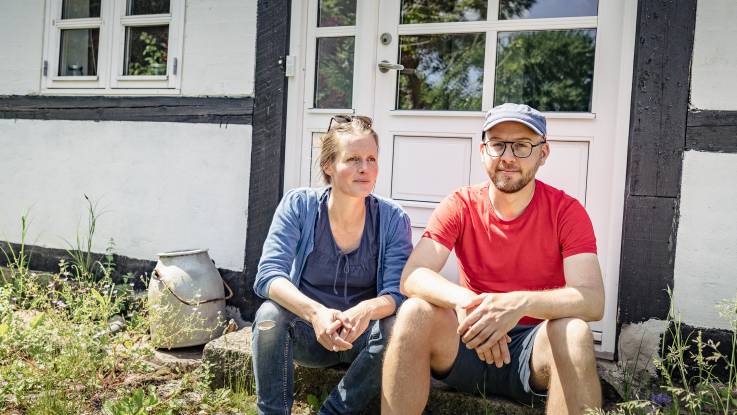
There is still much more to be done.
“But like many others, we were somewhat disappointed,” says Mikkelsen. “You don’t see or feel much of the energy island’s external image in day-to-day life. For example, it was a bit of a culture shock to find there was no waste separation here.” The new black bins with different-coloured lids have only been outside the islanders’ homes for a few weeks. Cerny also complains that old diesel ferries still connect the island with the mainland, despite attempts to change that, and that tractors and the island bus are not powered by solar electricity. “There is still much more to be done,” he says. And he wants to be a part of it.
That is why Hermansen appointed Cerny to the Energy Academy team, where criticism, ideas and commitment are always welcome – especially in the area of transportation. Samsø’s current goal is to completely abandon fossil fuels by 2030.
Letting ideas grow beyond individuals
But even without that goal, Samsø needs more people like Philipp Cerny – people who want to make a difference and dare to follow in Hermansen’s impressive footsteps when it’s time for him to pass on the baton. The island’s achievements in the area of green energy seem to depend on the individual man Søren Hermansen more than on the much-lauded community spirit. Hermansen grew up on a farm on Samsø and attended school on the mainland from the age of 15. He went on to work on fishing boats in Norway, in agriculture in New Zealand, and to gain a degree in environmental sciences before moving back to the island and taking over his father’s farm for a while. In 1984, Hermansen met his future wife Malene Lundén, a photographer from Copenhagen who also knew about group dynamics and leadership. She says she fell in love with him “because his sentences always had a ‘we’ in them”.
The couple became the driving force behind the project, although many helpers joined their efforts over the years. Lundén, who prefers to work in the background, started out by writing a book about the project. It was her idea to receive guests in a circle of chairs: “Because it encourages open discussion and creates a feeling of togetherness.” At the numerous community meetings, only those holding the “speaker’s staff” are allowed to speak. That way, the islanders don’t talk over one another and everyone receives equal attention.
The couple have invested a lot of personal energy over the years. They know how to talk to farmers and villagers as well as politicians, and have shown many different kinds of people how they could benefit from the energy transition. Their job is their life. “As a child, I was already helping out on the farm,” says Hermansen. “So it’s perfectly normal for me to work evenings and Sundays, doing everything required to keep the farm running.” Lundén adds: “That’s our lifestyle. Søren was often away at meetings abroad, sitting alone in hotel rooms instead of watching our children grow up. But that was entirely our choice – we’re like dance partners who take turns leading.”
So perhaps it is Malene Lundén and Søren Hermansen themselves who are the real shining examples here. There is no one-size-fits-all solution for the energy transition; a biomass heating plant or a wind turbine might not work everywhere. But people with agile and flexible minds, who can come up with viable and profitable ideas to act more sustainably at a local level, and who can convince the necessary people to implement those ideas – they are something the whole world could use. Naturally, Hermansen thinks this is an exaggeration: “It’s all well and good to put a talented striker on a football team to score the goals,” he says. “But without ten other players on the team, there wouldn’t be a match in the first place.” And with that, he dashes off – he has to quickly mow the lawn before joining a Zoom meeting with local government representatives in Canada.
Lead photo: Maria Feck / Translated from the German by Grace Winter / Babelfisch Translations. You can also read the report in German.
+ Update (2024) + Phillip Cerny is still actively involved in the Energy Academy, but now as an employee. He stepped down from the board after taking up his permanent position, but continues his voluntary activities as a board member of the Samsø Energy and Environment Office. As for the old diesel ferries, Cerny reports that, at least on the eastern side towards Zealand – the country’s largest and most populous island – two electric ferries will be operating from 2025.
Related stories
-
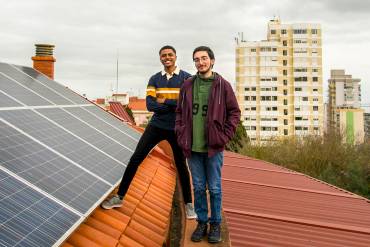
Solidarity through sunlight
Cooperative solar panels on the roofs of social facilities in Portugal show how citizens’ energy initiatives promote solidarity and community spirit.
-
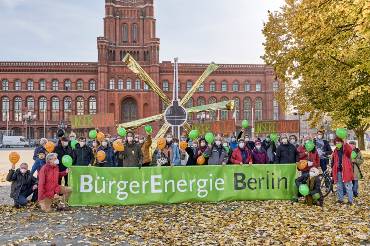
A beacon for Berlin
A Berlin cooperative has long been fighting for climate protection and citizen participation in the electricity grid. Now they’re on the home straight.
